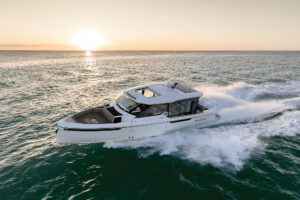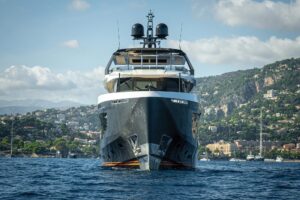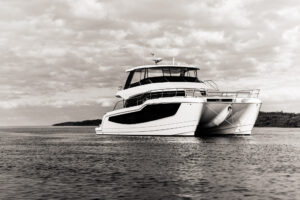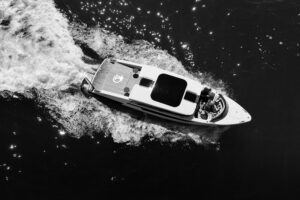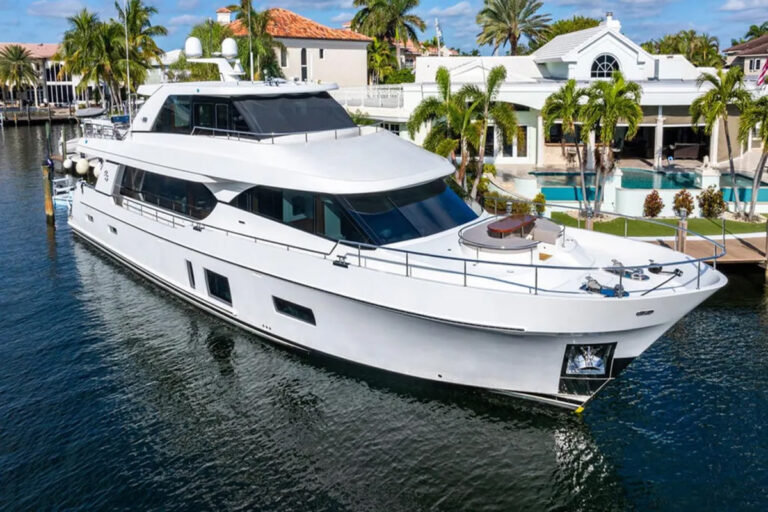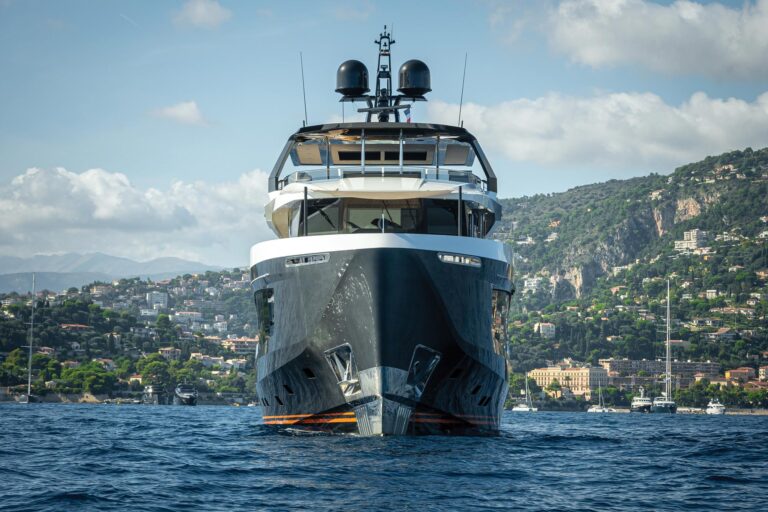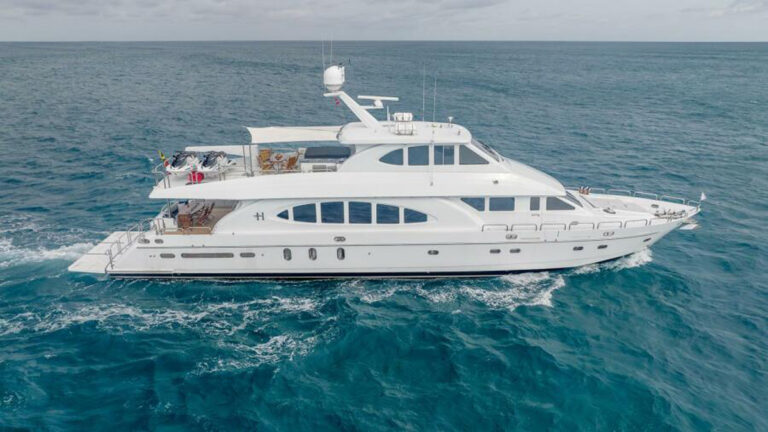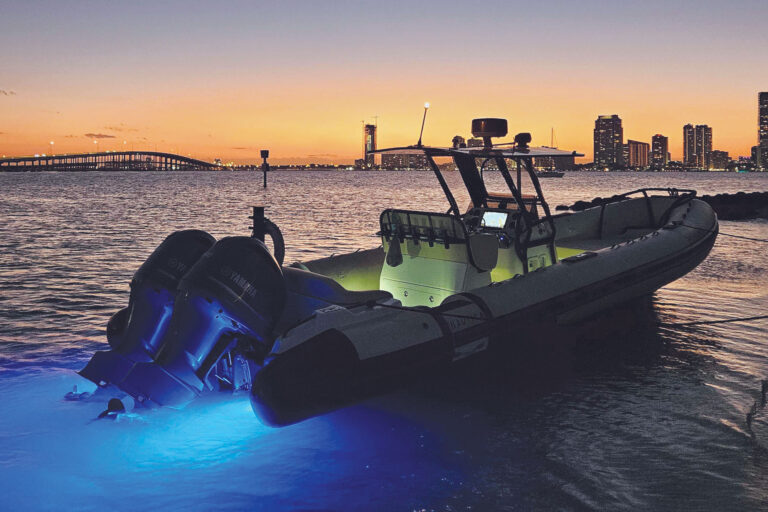Furuno’s recently introduced NavNetBB System will be warmly welcomed by both yacht owners who use the system and the technicians challenged with the design and installation of today’s increasingly capable and complex electronic suites. Building on their well-established NavNet radar, sonar, chart plotters, weatherfaxes and autopilots, Furuno’s NavNetBB expands the flexibility of the overall navigation with the addition of new stand-alone display screens and by separating the control functions from the displays.
The “BB”-Black Box-in the name summarizes the primary change in system architecture; virtually all signal and data processing is now accomplished in black-box modules that can be placed wherever is best from an installation standpoint. NavNet displays data on sunlight-readable waterproof screens or on standard computer monitors, as appropriate for the installation. The compact primary interface module can be situated in any location that serves the cabling requirements. Another (also compact) module contains all the controls. Its size lets the technician mount it in a position that ensures maximum ease of use under the most challenging sea conditions.
Some years ago, Furuno foresaw the need for data transfer rates far beyond the capability of the well-proven NMEA 0183 protocol or the still developing NMEA 2000 standard. The company responded to this need with the introduction of the ground-breaking Ethernet 10BASE-T NavNet system at the 1991 Miami Boat Show. Election of Ethernet avoided the need to develop a proprietary high-speed communication bus. At the time, however, the actual applications for the NavNet (Ethernet) bus were quite limited. The various Furuno data acquisition devices, radar scanners, fish finders and GPS receivers communicated over dedicated cables. Chart plotter processors and their software were housed in combined control/display modules. Ethernet communication links were largely used to transfer information among multiple display/control units and the vessel’s general-purpose computers. This picture began to change with the introduction of the black box FAX30 weatherfax receiver, which communicates solely via an Ethernet cable. The FAX30 was followed by the introduction of new Ethernet-connected black-box sonars, the BBFF1 and BBFF3.
The heart of the NavNetBB System is a black-box version of the central processor contained in the 1800-1900 radar/chart plotters. This new module, the Type RPU-014 Marine Radar Processor, is managed by the compact RCU-017 control. These two modules, connected to any one of five Furuno radar scanners and to a multi-purpose LCD, such as the 12.1-inch-diagonal model MU-120C, duplicate all of the functions available from the 1800-1900 series while adding the advantages of a larger display and greatly increased installation flexibility. The system extends all of the NavNet’s flexibility, including display of data on multiple screens and the sharing of information across the NavNet network. As before, networks are constructed using standard Ethernet hubs, greatly simplifying the design and installation of cabling. The flexibility of the NavNetBB extends to complex systems made up of many radar scanners and sonar data modules.
The RPU-014 measures only 15 x 11 x 4 inches and will be easy to mount in a location convenient for connection to the relatively large-diameter cable from the radar scanner. With luck, the installer won’t have to cut and splice the cable. The remaining cabling to the RPU-014 is easy to deal with. Remote mounting of the RPU-014 also avoids magnetic interference with the vessel’s standard or steering compass. The RCU-017 controller measures only 11 x 3.5 x 2.5 inches and can be mounted flush or on a trunnion-style bracket and can safely be positioned as close as 12 inches from the steering compass.
Anyone who is familiar with the 1800-1900 series of radar/chart plotters ought to have a zero learning curve with the BB system. Mariners who have experienced difficulty trying to operate control keys mounted on a vertical or nearly vertical surface in a seaway will appreciate the opportunity to mount the RCU-017 in a horizontal or close to horizontal position. Such a mounting lets you keep the heel of your hand in firm contact with a horizontal surface, providing a stable reference point for the finger motions needed to actuate the controls. When things get rough, you’ll be able to grasp the upper and lower edges of the control with thumb and middle finger, actuating the keys with the index finger.
In any Radar/Chart Plotter/Sonar system the ultimate value for navigation is determined by the image on the display screen. In our examination of the NavNetBB system we used Furuno’s new 12.1-inch-diagonal, MU-120C multi-purpose color LCD. This display measures 13 x 11 5/8 x 5 inches and weighs a hefty 12 pounds without the optional desktop mounting cradle. The maximum brightness level is sufficient for viewing the display in direct sunlight, although as with all LCDs or CRTs, a degree of shading will greatly enhance the image. The resolution meets the SVGA specification of 800 x 600 pixels. A coated non-glare glass window protects the landscape-oriented screen. The display can be installed in the instrument panel, mounted to a desktop or suspended from the overhead.
With all of the system’s controls located on the RCU-017, only the power button, menu, display, brilliance, picture-in-picture (PIP) and four cursor keys are required on the MU-120C display. A power indicator light and the window for the infrared remote control sensor are at the lower right. The overall appearance is clean and purposeful. In addition to its primary function in displaying radar, chart plotter and sonar data, the MU-120C can serve as a monitor for a wide variety of other devices. Data can be selected from either of two RGB sources, a DVI-D input or any one of three composite video inputs. Any one of the six inputs may occupy the entire screen, or any one of the three composite inputs can be shown in a PIP window.
The RMC-200 remote control allows you to select any one of the six data inputs to be displayed and any one of three PIP inputs. It also lets you open the extensive adjustment menus and control the screen’s brightness. The menus provide full control of the displayed image, and separate settings are available for the two RGB inputs, the DVI input and for each of the three composite video inputs. The selection options are extensive and include image size, position, color level, sharpness and color temperature. It should be possible to optimize the image from any source. The setup process is laudably clear and concise.
Furuno’s NavNetBB system seems well-suited to the increasingly comprehensive and complex navigation systems being installed on large yachts. We also believe the black-box approach will be very attractive for more basic systems, such as those typically assembled around the current stand-alone chart plotter/radar displays. The combination of installation flexibility afforded by the use of the RPU-014 black-box radar data processor, the control input convenience offered by compact RCU-017 control and the opportunity to use any SVGA monitor (or multiple monitors) will carry the BB system onto many smaller yachts and their limited amount of space. Prices: The NavNetBB Radar/Chart Plotter series starts at a MSRP of $4,895 for the 2.2kW, 24-mile version and goes to $9,995 for the 12kW, 72-mile model. The NavNetBB chart plotter only (GP1900CBB) has an MSRP of $3,895.
Contact: Furuno U.S.A., (360) 834-9300; www.furuno.com.
Click here to buy Furuno products.

